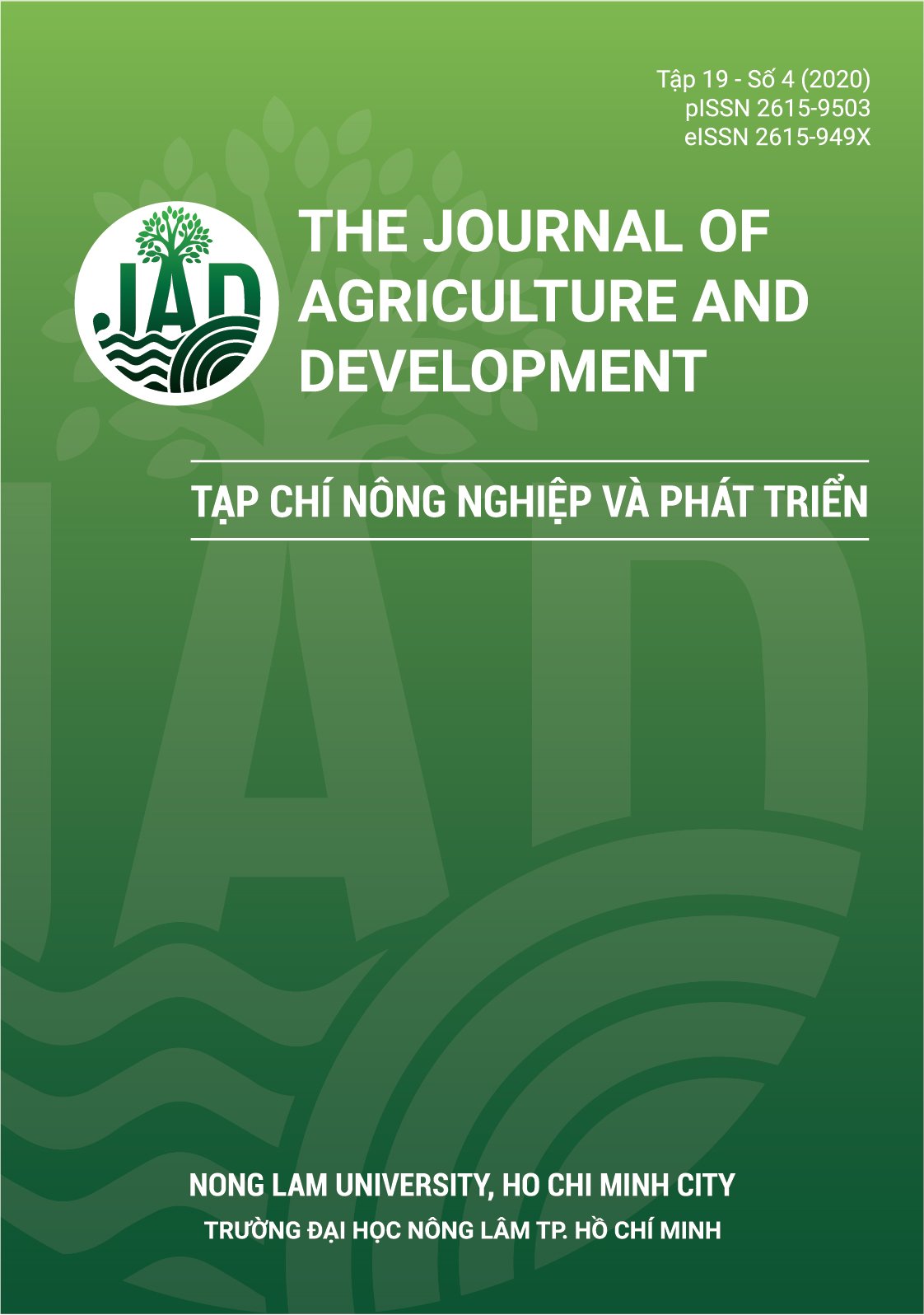Assessment of salinity intrusion in coastal districts of Ben Tre province using Landsat 8 image
Main Article Content
Abstract
Monitoring and evaluation of saline water intrusion is an important task, especially for agricultural production in Ben Tre province. The paper introduces a new solution in the application of Landsat 8 satellite imagery and field survey data to determine the soil electrical conductivity (EC) for soil salinity assessment through the distribu-tion of EC indice value. Analyzing and establishing the correlation between reflectance value, salinity indices and EC allow selecting a suitable model for the creation of a soil salinity map in 4 levels corresponding to EC values: no salinity (0 - 4), mild (4 - 8), moderate (8 - 16), very salinity (> 16). Research results in 2019 showed that most of the coastal districts of Ben Tre province were salty with EC values ranging from 8 to 16. The salinity decreased gradually from the East Sea to the mainland with the distance from 15 to 25 km. In brief, the study proposed solutions for rapid monitoring and evaluation of soil salinity based on the easy access of Landsat 8 images to calculate the necessary indices in the establishment of soil salinity maps for the local and regional scale.
Article Details
References
Abbas, A., & Khan, S. (2007). Using remote sens- ing techniques for appraisal of irrigated soil salinity. In Oxley, L., and Kulasiri, D. (Eds.), MODSIM 2007 International Congress: Modelling and Simulation Society of Australia and New Zealand (2632-2638). Christchurch, New Zealand: Modelling and Simulation Society of Australia and New Zealand. Retrieved March 20, 2020, from htps://researchoutput.csu.edu.au/en/publications/using-remote-sensing-techniques-for-appraisal-of-irrigated-soil-s
Ali, A. N., Mehdi, H., & Abbas, F. (2012). Models to the identification of soil salinity: A case study from Garmsar Plain, Iran. International Journal of Environmental Physiology and Toxicology 9(1), 59-74.
Dehni, A., & Lounis, M. (2012). Remote sensing techniques for salt affected soil mapping: Application to the oran region of Algeria. Procedia Engineering 33, 188-198. https://doi.org/10.1016/j.proeng.2012.01.1193
Douaoui, A. E. K., Nicolas, H., & Walter, C. (2006). Detecting salinity hazards within a semiarid context by means of combining soil and remote-sensing data. Geoderma, 134(1-2), 217-230. https://doi.org/10.1016/j.geoderma.2005.10.009
Khan, N. M., Rastoskuev, V. V., Shalina, E. V., & Sato,Y. (2001). Mapping salt-affected soils using remote sensing indicators - A simple approach with the use of GIS IDRISI. Proceedings of the 22nd Asian Conference on Remote Sensing (5-9). Singapore: Centre for Remote Imaging, Sensing and Processing (CRISP), National University of Singapore.
Le, T. V., Tran, V. T., & Vo, V. N. (2019). Solution of integrating remote sensing and GIS in monitoring saline intrusion of Mekong river. Vietnam Journal of Science, Technology and Engineering 61(3), 22-26.
MFF (Mangroves for the Future). (2014). Assessment of land use changes using SPOT5 multi-time remote sensing images in project areas of Ben Tre and Tra Vinh provinces. Tra Vinh, Vietnam. Retrieved June 11, 2019 from https://www.mangrovesforthefuture.org/.
Neha, P. (2019). Use of Landsat satellite imagery to identify the salitization of soil due to brine spills in North-western North Dakota (Unpublished master’s thesis). University of North Dakota, North Dakota, USA.
Nguyen, A. K., Liou, Y. A., Tran, H. P., Hoang, P. P.,& Nguyen, T. H. (2020). Soil salinity assessment by using near-infrared channel and vegetation soil salinity index derived from Landsat 8 OLI data: A case study in the Tra Vinh province, Mekong Delta, Vietnam. Retrieved March 15, 2020, from https://link.springer.com/article/10.1186/s40645-019-0311-0#article-info.
Shrestha, R. P. (2006). Relating soil electrical conductivity to remote sensing and other soil properties for assessing soil salinity in northeast Thailand. Land Degradation and Development 17(6), 677-689. https://doi.org/10.1002/ldr.752
USGS (United States Geological Survey). (2006). Landsat surface reflectance-derived spectral indices. Retrieved March 15, 2020, from https://www.usgs.gov/core-science-systems/nli/landsat/landsat-soil-adjusted-vegetation-index.
Watheq, S., Ebtihal, T. A. K., & Sa’ad, R. Y. (2018). Using Landsat 8 OLI data to predict and mapping soil salinity for part of An-Najaf governorate. Ecology, Environment and Conservation Paper 24(2), 572-578.








